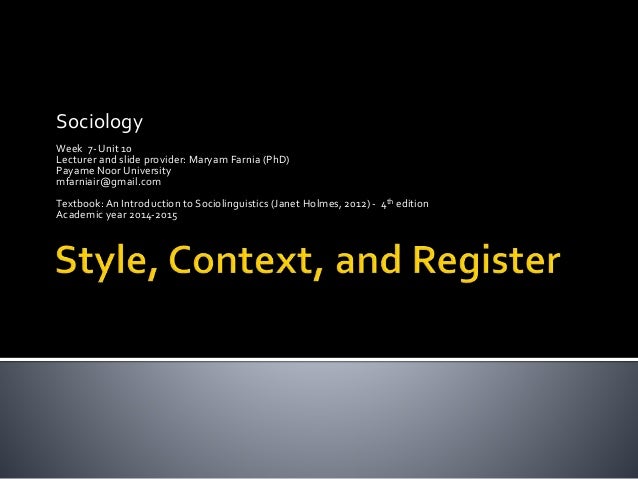2020. 3. 3. 23:13ㆍ카테고리 없음
Find more information about:ISBN:77222299283046OCLC Number:862929940Notes:Previous edition: 2008.Description:1 online resource (489 pages): illustrations.Contents:ContentsPreface to Fourth EditionPreface to Third EditionPreface to Second Edition Preface to First Edition Author's Acknowledgements Publisher's Acknowledgements 1. What do sociolinguists study? What is a sociolinguist? Why do we say the same thing in different ways?
An Introduction To Sociolinguistics Janet Holmes Summary


What are the different ways we say things? Social factors, dimensions and explanations Section I: Multilingual Speech Communities2. Language choice in multilingual communities Choosing your variety or code Diglossia Code-switching or code-mixing 3. Language maintenance and shift Language shift in different communities Language death and language loss Factors contributing to language shift How can a minority language be maintained? Language revival 4.
Linguistic varieties and multilingual nations Vernacular languages Standard languages Lingua francas Pidgins and creoles 5. National languages and language planning National and official languages Planning for a national official language Developing a standard variety in Norway The linguist's role in language planning Section II: Language Variation: Focus on Users6. Regional and social dialects Regional variation Social variation Social dialects 7. Gender and age Gender-exclusive speech differences: non-Western communities Gender-preferential speech features: social dialect research Gender and social class Explanations of women's linguistic behaviour Age-graded features of speech Age and social dialect data Age grading and language change 8. Ethnicity and social networks Ethnicity Social networks 9. Language change Variation and change How do changes spread? How do we study language change?
Reasons for language change Section III: Language Variation: Focus on Uses10. Style, context and register Addressee as an influence on style Accommodation theory Context, style and class Style in non-Western societies Register 11. Speech functions, politeness and cross-cultural communication The functions of speech Politeness and address forms Linguistic politeness in different cultures 12. Gender, politeness and stereotypes Women's language and confidence Interaction Gossip The linguistic construction of genderThe linguistic construction of sexuality Sexist language 13. Language, cognition and culture Language and perception Whorf Linguistic categories and culture Discourse patterns and culture Language, social class, and cognition 14. Analysing Discourse Pragmatics and politeness theoryEthnography of speaking Interactional sociolinguisticsConversation Analysis (CA)Critical Discourse Analysis (CDA)15. Attitudes and applications Attitudes to language Sociolinguistics and education Sociolinguistics and forensic linguistics 16.
Conclusion Sociolinguistic competence Dimensions of sociolinguistic analysis Sociolinguistic universals References Appendix: phonetic symbols Glossary IndexSeries Title:Responsibility:Janet Holmes.
Research interestsLanguage and Gender, Language in the Workplace, New Zealand English.BA Hons Leeds, MPhil Leeds, FRSNZJanet Holmes is Emeritus Professor in Linguistics at Victoria University of Wellington in New Zealand. She is a Fellow of the Royal Society of New Zealand and an Officer of the New Zealand Order of Merit (2016). She is Associate Director of the Wellington, an ongoing study of communication in the workplace which has described small talk, humour, management strategies, directives, and leadership in a wide range of New Zealand workplaces.
She was also Director of the project which produced the Wellington Corpus of Spoken New Zealand English which is available on CD-ROM. In the early 1990s, with Allan Bell and Mary Boyce, she conducted the first social dialect survey of New Zealand English in the Wellington area.